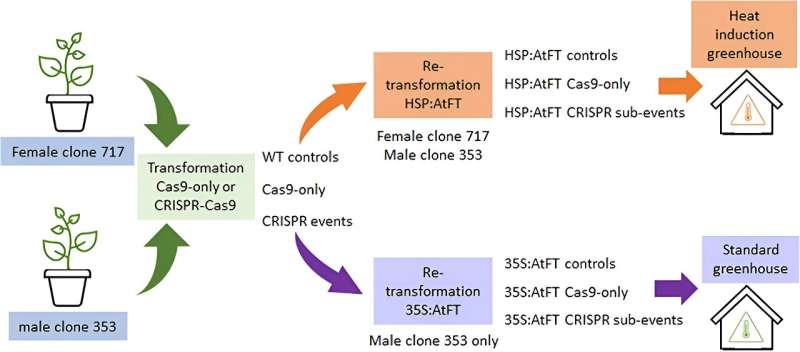This article has been reviewed according to Science X's editorial process and policies. Editors have highlighted the following attributes while ensuring the content's credibility:
fact-checked
peer-reviewed publication
proofread
Harnessing heat-induced floral overexpression using CRISPR techniques

Plant migration and gene flow from genetically modified or invasive plant species to wild relatives is a major public and regulatory concern. To counteract potential spread, various strategies have been developed, ranging from identifying naturally sterile plants to engineered sterility via gene editing.
As understanding of the molecular biology of flowering has advanced, techniques targeting conserved floral genes for genetic containment have emerged, such as RNAi and CRISPR technology.
Efforts to induce early flowering in trees include manipulating photoperiods and hormonal treatments, with genetic-accelerated flowering largely based on stable transformation. However, challenges arose when using these methods, such as varied responses in different clones and unintended impacts on the plant form.
The ultimate challenge lies in effectively controlling genetic flow without negatively affecting the overall floral form and vegetative structures of normally flowering trees.
In June 2023, Horticulture Research published a research paper titled "Variation in floral form of CRISPR knock-outs of the poplar homologs of LEAFY and AGAMOUS after FT heat-induced early flowering."
The study focused on optimizing early floral induction in 717 Populus tremula x Populus alba and 353 Populus tremula x Populus tremuloides clones. Using four different promoter and gene combination constructs (HSP:AtFT, 35S:PtFT1, 409S:AtFT, 35S:AtFT), the research aimed to induce early-flowering in selected clones.
Results showed that HSP:AtFT yielded the highest rate of flowering in both clones 717 and 353, while female clone 717 demonstrated a lower flowering rate than male clone 353.
The research further induced early-flowering in selected CRISPR trees from both clones, using either constitutive or heat-inducible floral constructs. Events with bi-allelic mutations in LFY or bi-allelic changes in both AG genes were selected from male clone 353 and female clone 717. These events were subsequently subjected to two experimental approaches: one using the constitutive 35S promoter driving AtFT expression, and the other using a heat-inducible floral construct.
The former approach, conducted on male clone 353, revealed that no flowering occurred in wild-type control trees, while retransformation of certain LFY events (DL106) produced flowering rates up to 83.3%. The latter approach involved retransforming selected events in both clones using a heat-inducible floral construct HSP:AtFT.
For clone 353, 22.4% of all trees flowered, while for clone 717, the flowering rate was 34.1%. Interestingly, despite the floral induction, the vegetative performance, measured by tree height, remained consistent across flowering and non-flowering trees in both clones. Additionally, while male clone 353 generally appeared healthy after heat induction, female clone 717 displayed some stress indicators, such as yellowing of lower foliage.
Lastly, in terms of floral morphology, while HSP:AtFT control trees typically produced a standard terminal catkin, retransformation events led to various atypical catkins and floral structures. Notably, AG knockout trees exhibited diverse replicated floral organs, with their appearance varying widely in terms of size and color.
In conclusion, this study successfully employed heat-induced FT overexpression to accelerate the assessment of floral phenotypes after a CRISPR knockout of key floral genes, LEAFY and AGAMOUS in poplar trees, and these modified poplar trees demonstrated a wide range of inflorescence and floral forms.
The findings not only highlight the potential horticultural value of these modifications but also present an early glimpse into the impact of knocking out particular genes on floral characteristics and apparent sterility, paving the way for potential applications in controlling plant breeding and mitigating gene flow concerns.
More information: Amy L Klocko et al, Variation in floral form of CRISPR knock-outs of the poplar homologs of LEAFY and AGAMOUS after FT heat-induced early flowering, Horticulture Research (2023). DOI: 10.1093/hr/uhad132
Journal information: Horticulture Research
Provided by TranSpread

















